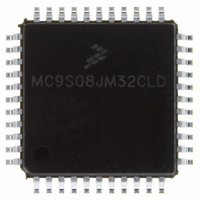MC9S08JM32CLD Freescale Semiconductor, MC9S08JM32CLD Datasheet - Page 207

MC9S08JM32CLD
Manufacturer Part Number
MC9S08JM32CLD
Description
IC MCU 8BIT 32K FLASH 44-LQFP
Manufacturer
Freescale Semiconductor
Series
HCS08r
Datasheet
1.MC9S08JM32CLD.pdf
(388 pages)
Specifications of MC9S08JM32CLD
Core Processor
HCS08
Core Size
8-Bit
Speed
48MHz
Connectivity
I²C, LIN, SCI, SPI, USB
Peripherals
LVD, POR, PWM, WDT
Number Of I /o
33
Program Memory Size
32KB (32K x 8)
Program Memory Type
FLASH
Ram Size
2K x 8
Voltage - Supply (vcc/vdd)
2.7 V ~ 5.5 V
Data Converters
A/D 8x12b
Oscillator Type
External
Operating Temperature
-40°C ~ 85°C
Package / Case
44-LQFP
Processor Series
S08JM
Core
HCS08
Data Bus Width
8 bit
Data Ram Size
2 KB
Interface Type
SCI/SPI
Maximum Clock Frequency
24 MHz
Number Of Programmable I/os
33
Number Of Timers
8
Maximum Operating Temperature
+ 85 C
Mounting Style
SMD/SMT
3rd Party Development Tools
EWS08
Development Tools By Supplier
DEMOJM, DEMOJMSKT, DEMOFLEXISJMSD, DEMO9S08JM16
Minimum Operating Temperature
- 40 C
On-chip Adc
8-ch x 12-bit
Lead Free Status / RoHS Status
Lead free / RoHS Compliant
Eeprom Size
-
Lead Free Status / Rohs Status
Lead free / RoHS Compliant
Available stocks
Company
Part Number
Manufacturer
Quantity
Price
Company:
Part Number:
MC9S08JM32CLD
Manufacturer:
Freescale Semiconductor
Quantity:
1 948
Company:
Part Number:
MC9S08JM32CLD
Manufacturer:
Freescale Semiconductor
Quantity:
10 000
- Current page: 207 of 388
- Download datasheet (5Mb)
external crystal and a maximum reference divider factor of 128, the resulting frequency of the reference
clock for the FLL is 62.5 kHz (greater than the 39.0625 kHz maximum allowed).
Care must be taken in the software to minimize the amount of time spent in this state where the FLL is
operating in this condition.
The following code sequence describes how to move from FEI mode to PEE mode until the 8 MHz crystal
reference frequency is set to achieve a bus frequency of 8 MHz. Because the MCG is in FEI mode out of
reset, this example also shows how to initialize the MCG for PEE mode out of reset. First, the code
sequence will be described. Then a flowchart will be included which illustrates the sequence.
Freescale Semiconductor
1. First, FEI must transition to FBE mode:
2. Then, FBE mode transitions into BLPE mode:
a) MCGC2 = 0x36 (%00110110)
b) Loop until OSCINIT (bit 1) in MCGSC is 1, indicating the crystal selected by the EREFS bit
c) Block Interrupts (If applicable by setting the interrupt bit in the CCR).
d) MCGC1 = 0xB8 (%10111000)
e) Loop until IREFST (bit 4) in MCGSC is 0, indicating the external reference is the current
f) Loop until CLKST (bits 3 and 2) in MCGSC are %10, indicating that the external reference
a) MCGC2 = 0x3E (%00111110)
b) Enable Interrupts (if applicable by clearing the interrupt bit in the CCR).
– BDIV (bits 7 and 6) set to %00, or divide-by-1
– RANGE (bit 5) set to 1 because the frequency of 8 MHz is within the high frequency range
– HGO (bit 4) set to 1 to configure external oscillator for high gain operation
– EREFS (bit 2) set to 1, because a crystal is being used
– ERCLKEN (bit 1) set to 1 to ensure the external reference clock is active
has been initialized.
– CLKS (bits 7 and 6) set to %10 in order to select external reference clock as system clock
– RDIV (bits 5-3) set to %111, or divide-by-128.
– IREFS (bit 2) cleared to 0, selecting the external reference clock
source for the reference clock
clock is selected to feed MCGOUT
– LP (bit 3) in MCGC2 to 1 (BLPE mode entered)
source
8 MHz / 128 = 62.5 kHz which is greater than the 31.25 kHz to 39.0625 kHz
range required by the FLL. Therefore after the transition to FBE is
complete, software must progress through to BLPE mode immediately by
setting the LP bit in MCGC2.
There must be no extra steps (including interrupts) between steps 1d and 2a.
MC9S08JM60 Series Data Sheet, Rev. 3
NOTE
NOTE
Multi-Purpose Clock Generator (S08MCGV1)
207
Related parts for MC9S08JM32CLD
Image
Part Number
Description
Manufacturer
Datasheet
Request
R
Part Number:
Description:
Manufacturer:
Freescale Semiconductor, Inc
Datasheet:
Part Number:
Description:
Manufacturer:
Freescale Semiconductor, Inc
Datasheet:
Part Number:
Description:
Manufacturer:
Freescale Semiconductor, Inc
Datasheet:
Part Number:
Description:
Manufacturer:
Freescale Semiconductor, Inc
Datasheet:
Part Number:
Description:
Manufacturer:
Freescale Semiconductor, Inc
Datasheet:
Part Number:
Description:
Manufacturer:
Freescale Semiconductor, Inc
Datasheet:
Part Number:
Description:
Manufacturer:
Freescale Semiconductor, Inc
Datasheet:
Part Number:
Description:
Manufacturer:
Freescale Semiconductor, Inc
Datasheet:
Part Number:
Description:
Manufacturer:
Freescale Semiconductor, Inc
Datasheet:
Part Number:
Description:
Manufacturer:
Freescale Semiconductor, Inc
Datasheet:
Part Number:
Description:
Manufacturer:
Freescale Semiconductor, Inc
Datasheet:
Part Number:
Description:
Manufacturer:
Freescale Semiconductor, Inc
Datasheet:
Part Number:
Description:
Manufacturer:
Freescale Semiconductor, Inc
Datasheet:
Part Number:
Description:
Manufacturer:
Freescale Semiconductor, Inc
Datasheet:
Part Number:
Description:
Manufacturer:
Freescale Semiconductor, Inc
Datasheet:











